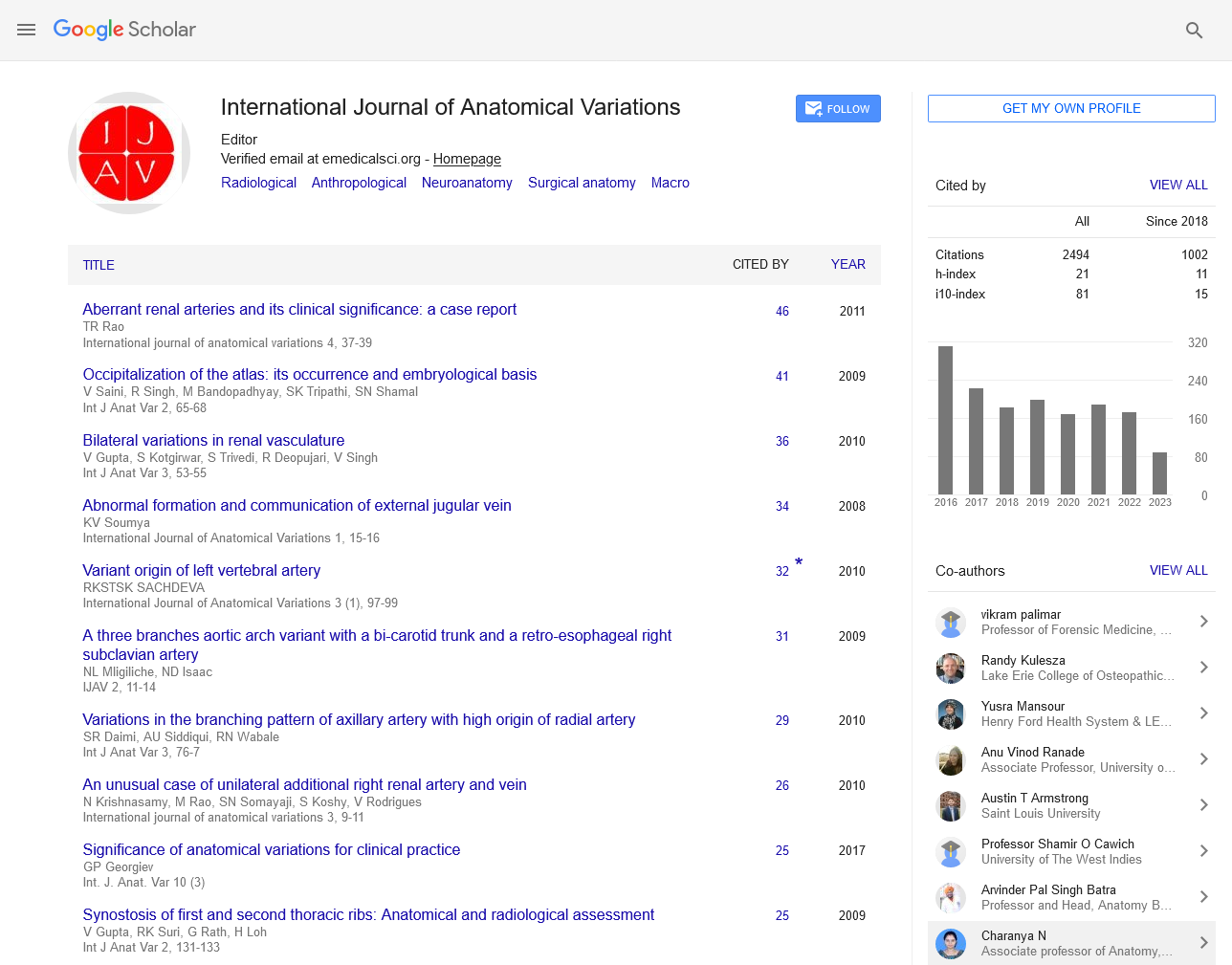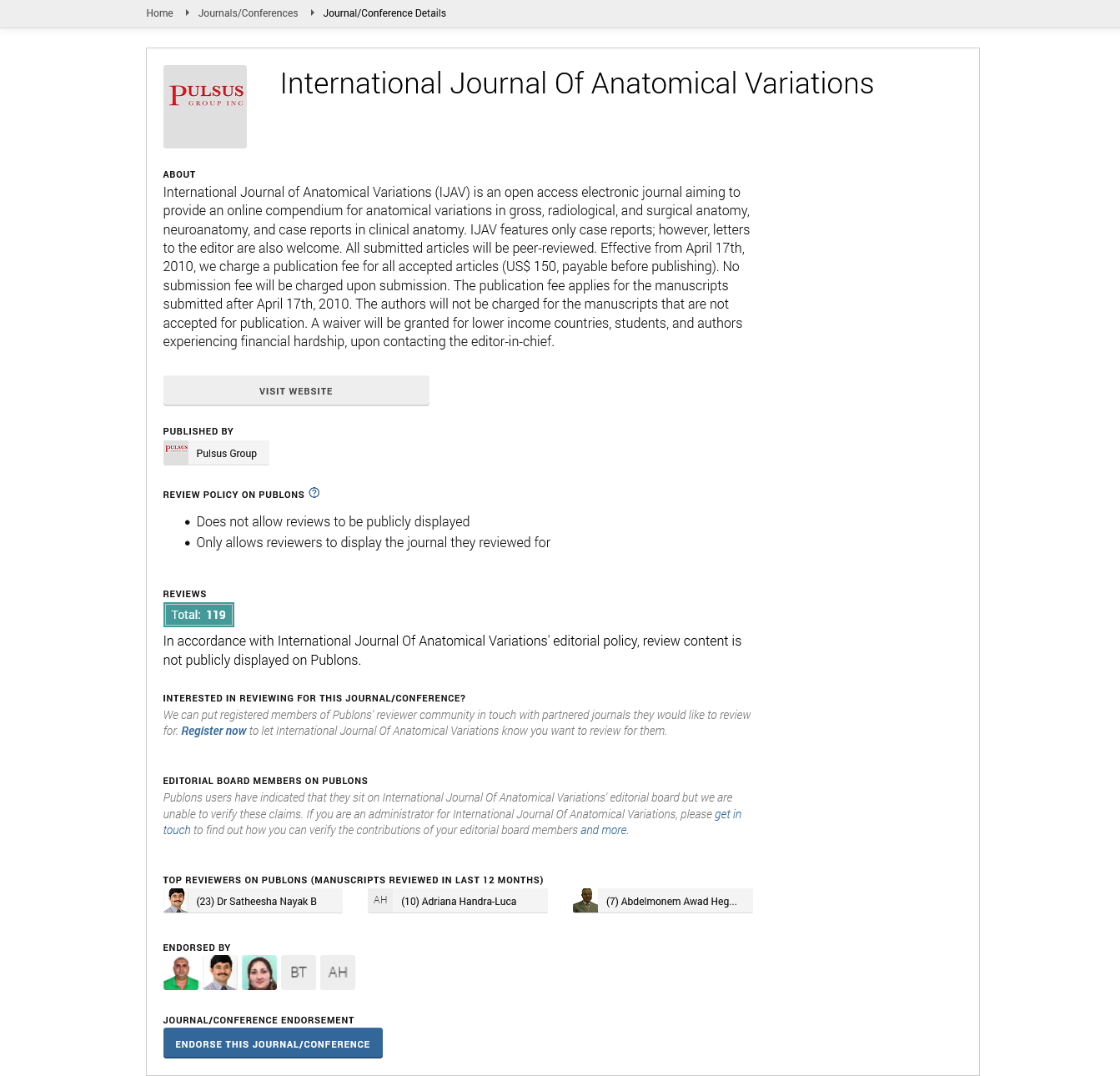Unusual Variations in the Anatomy of the Esophagus Clinical Implications for Esophageal Surgery and Endoscopic Procedures
Received: 02-Dec-2024, Manuscript No. ijav-24-7361; Editor assigned: 04-Dec-2024, Pre QC No. ijav-24-7361 (PQ); Reviewed: 18-Dec-2024 QC No. ijav-24-7361 ; Revised: 26-Dec-2024, Manuscript No. ijav-24-7361 (R); Published: 31-Dec-2024, DOI: 10.37532/1308-4038.17(12).468
Citation: Knapp M. Unusual Variations in the Anatomy of the Esophagus Clinical Implications for Esophageal Surgery and Endoscopic Procedures. Int J Anat Var. 2024;17(12): 705-706.
This open-access article is distributed under the terms of the Creative Commons Attribution Non-Commercial License (CC BY-NC) (http://creativecommons.org/licenses/by-nc/4.0/), which permits reuse, distribution and reproduction of the article, provided that the original work is properly cited and the reuse is restricted to noncommercial purposes. For commercial reuse, contact reprints@pulsus.com
Abstract
The esophagus is a crucial organ in the digestive system, and unusual anatomical variations can significantly affect the management of esophageal conditions. These variations, which can be congenital, acquired, or pathology-related, present unique challenges for both esophageal surgery and endoscopic procedures. Congenital anomalies such as esophageal atresia, tracheoesophageal fistula, and congenital stenosis, along with esophageal diverticula (Zenker’s, traction, and epiphrenic), vascular anomalies like esophageal varices, and motility disorders such as achalasia, can complicate diagnosis and treatment. These variations necessitate precise preoperative imaging and tailored surgical approaches to prevent complications such as bleeding, perforation, or poor functional outcomes. Understanding these uncommon anatomical variations is essential for improving the success of esophageal surgeries and endoscopic interventions, ultimately optimizing patient care.
Keywords
Esophageal anatomy; Esophageal variations; Esophageal surgery; Endoscopic procedures; Congenital anomalies; Gastroesophageal reflux disease (GERD); Esophageal strictures; Esophageal diverticula; Esophageal cancer; Esophageal varices
INTRODUCTION
The esophagus is a vital organ in the digestive system that serves as the conduit for food and liquids from the mouth to the stomach. Anatomically, the esophagus is a muscular tube that extends from the pharynx to the stomach, passing through the mediastinum in the thoracic cavity. While the esophagus generally follows a predictable anatomical course, there are various unusual anatomical variations that can have significant clinical implications for both esophageal surgery and endoscopic procedures. These variations, which can be congenital, acquired, or due to underlying pathology, may complicate diagnosis, treatment, and surgical intervention. Understanding the anatomical intricacies of the esophagus is critical for clinicians involved in esophageal surgery, endoscopy, and the management of esophageal disorders. This article reviews some of the most unusual variations in the anatomy of the esophagus and their clinical implications, particularly for surgical and endoscopic procedures [1].
OVERVIEW OF NORMAL ESOPHAGEAL ANATOMY
The esophagus typically spans from the lower part of the pharynx at the level of the cricoid cartilage to the stomach at the gastroesophageal junction. It is approximately 25 cm long and has three major anatomical regions: the cervical esophagus (upper part), the thoracic esophagus (middle part), and the abdominal esophagus (lower part). The esophagus is lined by smooth muscle, with the upper third composed of striated muscle, the middle third a mix of both, and the lower third predominantly smooth muscle. The sphincters at both ends the upper esophageal sphincter (UES) and lower esophageal sphincter (LES) control the entry of food into the esophagus and prevent reflux of stomach contents. Despite its generally consistent structure, there are several variations in the esophagus that can present challenges in clinical practice. These variations can affect the pathophysiology of esophageal diseases, complicate endoscopic examinations, and influence the approach to surgery [2].
TYPES OF UNUSUAL ESOPHAGEAL ANATOMICAL VARIATIONS
Congenital Esophageal Anomalies
Congenital esophageal anomalies are rare but can have significant consequences for individuals diagnosed in early life or adulthood. These include conditions such as
Esophageal Atresia and Tracheoesophageal Fistula (TEF): This congenital malformation occurs when the esophagus does not develop properly, leading to a gap between the esophagus and the stomach, or an abnormal connection between the esophagus and the trachea. It is commonly diagnosed in neonates but may also have long-term consequences if undiagnosed in adulthood. Surgery is often required to correct these anomalies.
Congenital Esophageal Stenosis: This rare condition involves a narrowing of the esophagus, which can be due to a developmental defect in the esophageal lining or muscle. Patients with congenital esophageal stenosis often present with dysphagia (difficulty swallowing), and the condition may require surgical intervention, typically dilation or resection.
Double Esophagus: A double esophagus occurs when there are two parallel esophageal tubes, one of which may be non-functional or underdeveloped. This rare anomaly is usually associated with significant clinical symptoms, including dysphagia, and may require surgical correction.
These congenital variations can complicate surgical procedures, particularly when performing esophagectomy or anastomosis, as the altered anatomy requires precise surgical planning.
Esophageal Diverticula
Esophageal diverticula are pouch-like outpouchings of the esophageal wall that can occur in any segment of the esophagus. The three most common types of esophageal diverticula are:
Zenker’s Diverticulum: A pulsion-type diverticulum located in the upper esophagus, just above the upper esophageal sphincter. It occurs due to increased pressure and is associated with dysphagia, regurgitation, and aspiration. Zenker’s diverticulum can complicate endoscopic procedures, as the diverticulum may be mistaken for a tumor or other masses. Surgical excision or endoscopic stapling is often required.
Traction Diverticula: These are generally located in the mid-esophagus and occur due to scarring from inflammation or previous infection, such as tuberculosis. Traction diverticula are less symptomatic than pulsion diverticula but can complicate surgical access or endoscopic evaluation, especially if large or near the gastroesophageal junction.
Epiphrenic Diverticula: These diverticula occur in the lower third of the esophagus, typically near the diaphragm. They are often associated with motility disorders like achalasia. Epiphrenic diverticula can lead to food stasis and regurgitation, and their management may involve diverticulectomy or endoscopic removal, which can be complicated by their proximity to the LES.
Endoscopic techniques, such as flexible esophagoscopy, are critical in diagnosing and evaluating diverticula, but care must be taken to avoid perforation. Surgical management often involves diverticulectomy or diverticular stapling, with close attention to preserving esophageal function.
Esophageal Vascular Anomalies
Esophageal vascular anomalies, including abnormal arteries, veins, and blood vessels, can complicate both endoscopic procedures and surgical interventions. These anomalies are often congenital but can be exacerbated by conditions like portal hypertension.
Esophageal Varices: A common manifestation of portal hypertension, esophageal varices are dilated veins that can rupture and lead to life-threatening bleeding. These varices are often seen in patients with cirrhosis or other liver diseases. Endoscopic evaluation and intervention, such as banding or sclerotherapy, are crucial in managing variceal bleeding. However, the presence of varices can complicate procedures, as excessive manipulation may increase the risk of rupture.
Aberrant Arteries: In some cases, aberrant arteries, such as the right aortic arch or unusual branches of the subclavian artery, may compress the esophagus and cause dysphagia. These vascular anomalies may be missed during standard imaging, and their presence may necessitate careful preoperative planning and consideration during surgery, especially when performing esophagectomy or resection.
Esophageal Motility Disorders
Although primarily functional rather than structural, esophageal motility disorders can alter the effective anatomy of the esophagus and complicate surgical procedures. These conditions include:
Achalasia: A disorder where the LES fails to relax, leading to a dilated esophagus and difficulty swallowing. Achalasia often requires surgical intervention, such as pneumatic dilation, Heller myotomy, or peroral endoscopic myotomy (POEM). Unusual variations of the esophagus in patients with achalasia, such as megaesophagus, can complicate the surgical approach due to the increased size of the esophagus and its potential to complicate gastric access.
Diffuse Esophageal Spasm (DES): In this condition, uncoordinated esophageal contractions may cause chest pain and dysphagia. While it is typically managed conservatively with medications, patients undergoing endoscopic procedures or surgery may present challenges due to the intermittent nature of the spasms.
Esophageal Malformations and Tumors
Esophageal tumors or malformations, though not variations in the conventional sense, can present as unusual anatomical changes. Benign tumors such as esophageal leiomyomas or malignant tumors like esophageal cancer can alter the shape or passage of the esophagus, complicating both endoscopic evaluation and surgical resection. Tumors may obstruct the esophagus, making it difficult to pass an endoscope or achieve clear visualization during surgery. In such cases, preoperative imaging, biopsy, and staging become critical in determining the best course of action.
CLINICAL IMPLICATIONS FOR ESOPHAGEAL SURGERY
Surgical Approach
Unusual variations in esophageal anatomy require precise preoperative imaging and careful planning. Esophagectomy, fundoplication, and other esophageal surgeries must take into account anatomical differences such as diverticula, vascular anomalies, and congenital malformations. Surgeons may need to adapt their techniques, using robotic-assisted surgery or minimally invasive approaches to reduce complications and improve patient outcomes.
Intraoperative Complications
Certain anatomical variations may lead to intraoperative complications, such as bleeding due to vascular anomalies or difficulty identifying key anatomical structures during surgery. Patients with esophageal diverticula may also have thicker or more fibrous tissue, complicating resection or suturing.
CLINICAL IMPLICATIONS FOR ENDOSCOPIC PROCEDURES
Endoscopic Diagnosis and Treatment
Endoscopic procedures, including flexible esophagoscopy and endoscopic retrograde cholangiopancreatography (ERCP), play a critical role in diagnosing and treating esophageal conditions. Unusual anatomical variations, such as diverticula or vascular malformations, can obstruct the view, making it challenging to accurately diagnose or treat the condition. Endoscopists must be vigilant in recognizing variations and taking extra care to avoid complications such as perforation.
Management of Esophageal Varices
Endoscopic interventions for esophageal varices, such as banding or sclerotherapy, can be life-saving in patients with portal hypertension. However, the presence of other vascular anomalies may increase the complexity of the procedure. Special care must be taken to avoid damaging normal vessels while targeting the varices for treatment.
CONCLUSION
Unusual variations in the anatomy of the esophagus are rare but important considerations for clinicians performing esophageal surgery or endoscopic procedures. These anatomical differences can complicate the diagnosis and treatment of esophageal disorders, particularly in conditions such as esophageal diverticula, vascular anomalies, and congenital malformations. Clinicians must be aware of these variations and adapt their approaches to ensure successful outcomes, particularly in complex cases requiring surgery or endoscopic interventions. Understanding the esophagus's anatomical complexity is essential for improving patient safety, enhancing diagnostic accuracy, and optimizing therapeutic interventions.
REFERENCES
- Huang YT, Huang YL, Ng KK, Lin G. Current status of magnetic resonance imaging in patients with malignant uterine neoplasms: A review.KJR. 2019; 20(1):18–33.
- Hughes L, Roex A, Parange A. STUMP, a surprise finding in a large fibroid uterus in a 20-year-old woman.Int J Womens Health. 2018; 10:211–214.
- George S, Serrano C, Hensley ML, Ray-Coquard I. Soft tissue and uterine Leiomyosarcoma.Journal of Clinical Oncology. 2018; 36(2):144–150.
- Zhang G, Yu X, Zhu L, Fan Q et al. Preoperative clinical characteristics scoring system for differentiating uterine leiomyosarcoma from fibroid.BMC Cancer. 2020; 20(1).
- Mayerhofer K, Obermair A, Windbichler G, Petru Eet al.Leiomyosarcoma of the uterus: A clinicopathologic multicenter study of 71 cases.Gynecol Oncol. 1999; 74(2):196–201.
- Arend RC, Toboni MD, Montgomery AM, Burger RAet al.Systemic Treatment of Metastatic/Recurrent Uterine Leiomyosarcoma: A Changing Paradigm.Oncologist. 2018; 23(12):1533–1545.
- Damerell V, Pepper MS, Prince S. Molecular mechanisms underpinning sarcomas and implications for current and future therapy.Signal Transduction and Targeted Therapy. 2021; 6(1).
- Cui RR, Wright JD, Hou JY. Uterine leiomyosarcoma: a review of recent advances in molecular biology, clinical management and outcome.BJOG: Int. J Obstet Gynaecol. 2017; 124(7):1028–1037.
- Santos P, Cunha TM. Uterine sarcomas: Clinical presentation and MRI features.Diagnostic and Interventional Radiology. 2015; 21(1):4–9.
- Cree IA, Tan PH, Travis WD, Wesseling Pet al.Counting mitoses: SI (ze) matters!Modern Pathology. 2021; 34:1651–1657.
Indexed at, Google Scholar, Crossref
Indexed at, Google Scholar, Crossref
Indexed at, Google Scholar, Crossref
Indexed at, Google Scholar, Crossref
Indexed at, Google Scholar, Crossref
Indexed at, Google Scholar, Crossref
Indexed at, Google Scholar, Crossref
Indexed at, Google Scholar, Crossref
Indexed at, Google Scholar, Crossref






